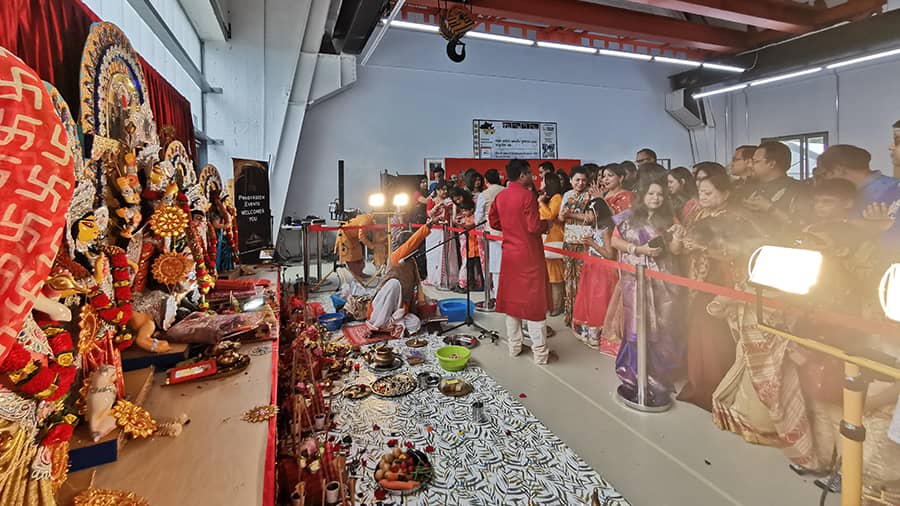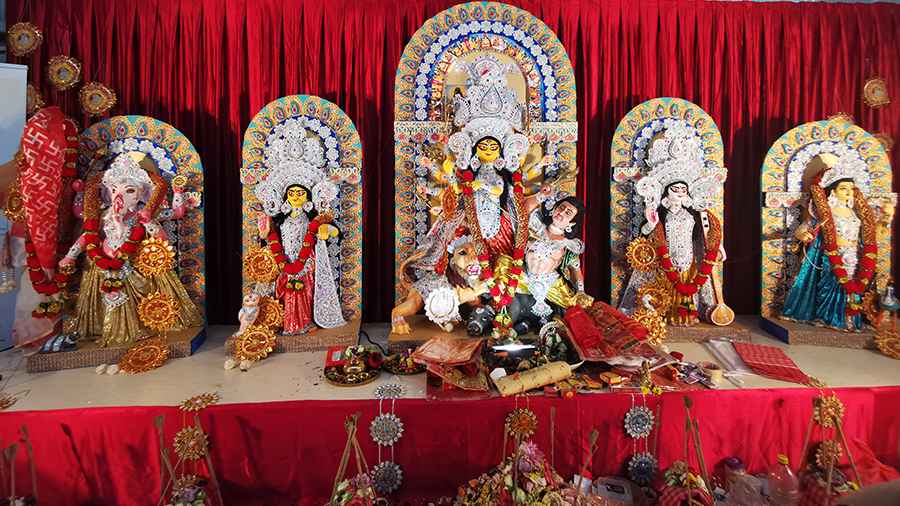If anyone has ever been to Kolkata during Durga Puja, they would know why Bengalis all over the world wait the entire year for these four days. No matter wherever they are, whenever you talk to a Bengali about their beloved ‘pujo’, you would see their eyes light up and fall into a daze as they recount their experiences of the festival.
Pandal-hopping, barir pujo, brishti, protima, adda, khaoa are the common verbs that intersperse the conversations until they coagulate to become the definition of what they call their ‘home’.
But what happens when home becomes a place away from the city that dresses up for the festival that every Bengali heart desires? What happens when you feel pujo-pujo but without the dhaaker awaj, the purohit chanting mantras over the microphones, the dhunuchi naach, the multi-coloured fairy lights lighting up every street and the indomitable excitement pulsing through the very veins of the city?
The answer to both these questions becomes the ‘probasi bangali’s’ intense desire to recreate to some extent the embers of the festival that had been an integral part of their lives, until work, education or circumstances forced them to relocate.
This is what I felt when I stepped on Sashthi evening in DomagKAteliers Halle50 — a studio in Munich, Germany, rented for conducting Durga Puja. Even though it was already 11pm in Kolkata, it was only 7.30pm in Germany. My jet-lagged body was signalling that it was time for bed by inducing a blinding headache, but I decided to brave it all — coat, kurti, makeup and the cold, rainy weather. Despite the trying conditions, the inside of the atelier was throbbing with the enthusiasm of 200-odd Bengalis, all dressed up in their best Puja attire (probably brought by their relatives from India or bought during vacations) and gushing about the food that consisted of everything from biryani to lachha paratha with mutton curry to papri chaat and masala cold drinks. It was hard to imagine that I was, in fact, 7,194km away from Kolkata. Amid the loud conversations, the kids running around and the tantalising smell of delicacies, I had to pinch myself to remember that I hadn’t stepped into an alternate universe — far away from the uniform streets, the blandly painted house and the sparse population of Munich.
The spirit of Bangaliana

Members offer pushpanjali on Ashtami morning
Created in 2014 on August 9, as a culmination of a long-cherished desire of eight probasi Bangalis, Sampriti München e.V, is a community of Bengalis primarily hailing from West Bengal. Initially, Durga Puja was not the reason why Sampriti München e.V was created. Bringing the community of Bengali students, professionals and artists together was the primary intention. This spirit of ‘community’-binded Bengalis, who enjoy all their festivals together — Sarwasati Puja, Lakshmi Puja, Poila Baisakh and Dol being the most frequently celebrated ones.
Anubhab Dasgupta, the secretary of Sampriti München e.V, who has been with the community since it was conceived, recounts how in 2018 the members had been asked if they would like to commit to the Durga Puja being celebrated regularly on a large scale. “Seeing the spirit of the members, we were assured that we would be able to celebrate the Puja every year and thus we started organising it from 2019, though in the beginning, we had insufficient funds,” said Dasgupta. Despite Germany's timezone being three and a half hours behind India, the rituals are conducted on the designated days with certain alterations to suit the local time. While the priest is invited from Kolkata every year, the idol sourced from well-known Kumartuli artisan, Kaushik Ghosh, is reused. The food is made and sponsored by the members. It is not difficult to see the dedication of the Bengali diaspora in Munich. The pujo planning starts four months in advance and everything from the organisation to the decoration sees the active participation of all the members.
You can take the Bengali out of Bengal, but not Bengal out of a Bengali

The members dance to Rabindra Sangeet
But what is pujo without gaan-bajna? Residents of Kolkata would know that pujo doesn’t really feel like it if there isn’t music blaring from the microphones courtesy the parar functions (or otherwise) and the members of Sampriti München e. V cannot agree more. Even without the loud music, cultural activities always play a big role in all their celebrations. With a dedicated cultural secretary as well as a choice of musicians, singers and dancers within the community — the pujo evenings are hardly a bore. Even before you’ve walked into the atelier bursting at its seams, you’re asked to take a seat to witness the members performing a well-loved Rabindra Sangeet or folk song, accompanied by guitars, cajon and keyboards; the women executing to perfection a well-choreographed dance routine; the children putting up a modern version of Sukumar Ray’s Lokkhoner Shaktishel, and if you’re lucky — all the members bursting into a flash mob, dancing to ‘Dhaaker Taaley’ and ‘Dhaak Baja Kashor Baja’. For me, however, this was something new. The pujo days would generally find me pandal-hopping throughout the day with no time to watch any of the events painstakingly organised by the local committee. But seeing members across all age groups perform, it brought back memories from my childhood, when I too had put up a dance performance without any talent for dance whatsoever, much to my dislike and my mother’s happiness.
With the idol flanked on one side and the food being served under tents just outside the hall, the crowd, the continuous screech of joyous children and the general commotion reminded me of Kolkata. Much like the thrill and exhaustion of standing in long queues to watch the idol or the bustling roads with food stalls and pedestrians walking even in the wee hours, the atelier resounded with the cumulative mirth of its members — old and young alike. Truly, one can take the Bengali out of Bengal but not Bengal’s culture and heritage out of a Bengali — no matter where they are.
‘All’s well that ends well'…
...Says the bard and nothing rings truer for the members of Sampriti München e.V. While my tryst with cultural activities, food and the rituals were all exciting and, to some extent, unbelievable, I was still not prepared for what transpired at the end of these days. With dinner being completed by 10.30pm (Germans are sticklers for punctuality, as you know) and members nearing the end of their photography session, what starts is a passionate round of bhashan dance to dhaak and knashor ghonta, played in turns by several talented percussionists from the community. With men and women bringing out their best moves, for the older generation (who have come to visit), it becomes a spectacle to witness their not-so-small children and grandchildren participate gleefully in a community that feels like home away from home.
While Germany’s incessant rains mirror the ones in Bengal during shorot, the country's chilling cold is countered by the warmth of its people, united by their mutual love for a season, a culture, a festival and indeed a community spread across geographical borders.
